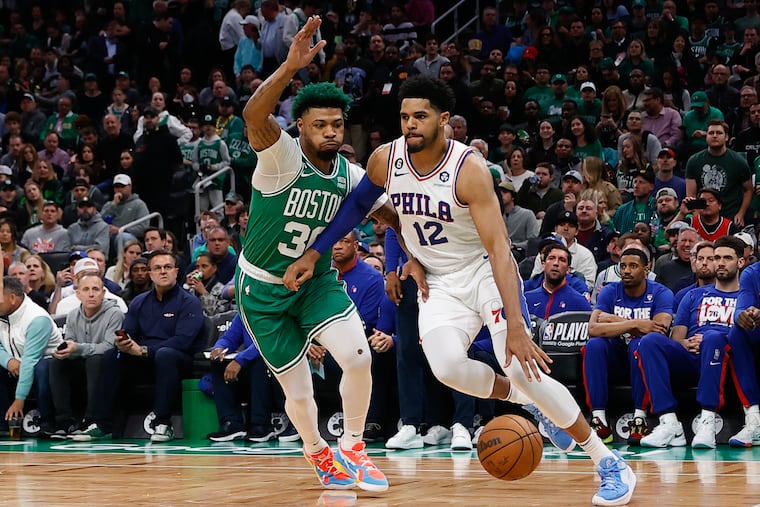Tobias Harris is the key to the Sixers’ post-draft offseason, regardless of James Harden
What might the Sixers realistically get back for Harris in a trade? Here's what we know.

There’s a concept in psychology known as motivated reasoning that says our hopes and desires often hamper our ability to solve a problem. We conflate reality with what we want reality to be. Our motivations cloud our judgment. It’s the stuff of inside straight draws and long irons out of the rough and conclusions like, “They’re probably just friends.” Pretty much every major geopolitical blunder is the product of a heavy dose of motivated reasoning.
Same goes for every hypothetical Tobias Harris trade.
Zack LaVine, Zion Williamson, O.G. Anunoby — that’s not the sort of return anybody should be expecting if the Sixers decide to trade their veteran forward. Daryl Morey is a fine executive, but he isn’t MKULTRA. Teams don’t trade young All-Stars for older non-All-Stars. Especially not when the young All-Stars are under contract for more years and lower salaries than the old non-All-Star.
» READ MORE: Sixers to add Azuolas Tubelis, Terquavion Smith and Ricky Council IV to two-way contracts
More likely is a deal similar to the one Morey struck shortly after signing on with the Sixers in 2020, when he essentially swapped Al Horford for Danny Green by giving the Thunder a future first-round pick and an early second-round pick. Or some version of the Russell Westbrook trade the Lakers executed at this year’s trade deadline, which netted them a trio of players who logged significant minutes during their run to the Western Conference finals. Neither situation is a perfect parallel to Harris. But the return is more in line with what the Sixers should expect: some combination of complementary veteran pieces and cap room.
The big unknown is what matters more: the cap room or the complementary pieces. A lot of that hinges on what happens with James Harden. If the Sixers end up re-signing their star point guard, any cap considerations will be more or less a moot point in any decision to trade Harris. In that situation, it would make sense to deal him only in a scenario in which the player(s) they are getting back make them a better team than Harris would. Think of that Westbrook deal, which landed the Lakers’ De’Angelo Russell, Malik Beasley, and Jared Vanderbilt in exchange for a veteran who wasn’t as good of a fit as the aggregate of those three. I would assume that Harris’ value is greater than Westbrook’s was at last year’s trade deadline. The big question is how much?
» READ MORE: Villanova standout Cam Whitmore, who dropped to No. 20, vows not to let draft 'faze me'
If Harden does not end up re-signing, cap room could be a bigger consideration. Right now, the Sixers don’t have any. The good news is they don’t need any to re-sign Harden. The bad news is they won’t have any even if they don’t re-sign Harden. Which means the only way they’d be able to replace him in free agency is by shedding some of their current salary. Otherwise, the most they’d be able to spend on the open market is somewhere in the neighborhood of the $12 million mid-level exception, which is roughly half of what it would take to sign a player like the Raptors’ Fred Van Vleet (just as an example).
» READ MORE: Top 10: The Sixers’ worst draft-day decisions, including the Moses Malone and Mikal Bridges trades
With a salary of $39 million, Harris offers the Sixers’ the best chance to shed enough salary to generate the cap room they’d need to sign a star-level player (think Van Vleet, for instance).
This sets up a conundrum. Cap room is the second scarcest asset on the offseason market, behind only superstars. Most of the teams who would be interested in a player like Harris are competitive teams who are already near or over the salary cap. Such a team would need to part with a (roughly) equal amount of salary to Harris’. But it would defeat the purpose for the Sixers to acquire that salary unless they are able to deal it elsewhere.
One way or another, the Sixers would likely need to involve themselves with a team that has the cap room to absorb a contract, whether it is Harris’ or one or more of the pieces that get traded for him. As we noted above, cap room is a scarce asset, and the few teams with it are able to charge a pretty penny for it. Go back to the Horford trade three years ago: the Sixers traded the Thunder a lightly protected first-round pick and a pick just outside the first round in order to shed the three years and $82 million or so left on Horford’s contract. That was the cost of doing business.
» READ MORE: How the Sixers nearly drafted Bill Walton 50 years ago
Presumably, Harris will have a much broader market than Horford. He’s still a fine player who could help a team like Indiana or Cleveland get appreciably better. Swapping Harris for a player like Buddy Hield could benefit both teams, with the Sixers getting more of a pure shooter to go with the $19 million they’d save on salary. Such a move would give them a lot more flexibility to accommodate a star-level salary in free agency. It might also prevent them from having to part with the one future first-round pick in their possession. That being said, if Harden ends up returning, the cap room would be moot, and the Sixers would have swapped out Harris for Hield and nothing more.
It’s a fascinating offseason for the Sixers. The trade market is already percolating. But the Sixers’ role in it likely depends on Harden’s decision. Stay tuned. Just don’t get your hopes too high.